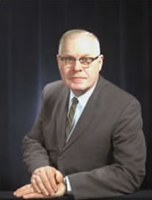
Murray Leinster was a pen name of William Fitzgerald Jenkins, an American writer of genre fiction, particularly of science fiction. He wrote and published more than 1,500 short stories and articles, 14 movie scripts, and hundreds of radio scripts and television plays.

In the history of cryptography, the "System 97 Typewriter for European Characters" or "Type B Cipher Machine", codenamed Purple by the United States, was an encryption machine used by the Japanese Foreign Office from February 1939 to the end of World War II. The machine was an electromechanical device that used stepping-switches to encrypt the most sensitive diplomatic traffic. All messages were written in the 26-letter English alphabet, which was commonly used for telegraphy. Any Japanese text had to be transliterated or coded. The 26-letters were separated using a plug board into two groups, of six and twenty letters respectively. The letters in the sixes group were scrambled using a 6 × 25 substitution table, while letters in the twenties group were more thoroughly scrambled using three successive 20 × 25 substitution tables.

William Frederick Friedman was a US Army cryptographer who ran the research division of the Army's Signal Intelligence Service (SIS) in the 1930s, and parts of its follow-on services into the 1950s. In 1940, subordinates of his led by Frank Rowlett broke Japan's PURPLE cipher, thus disclosing Japanese diplomatic secrets before America's entrance into World War II.

Frank Byron Rowlett was an American cryptologist.
Cryptography was used extensively during World War II because of the importance of radio communication and the ease of radio interception. The nations involved fielded a plethora of code and cipher systems, many of the latter using rotor machines. As a result, the theoretical and practical aspects of cryptanalysis, or codebreaking, were much advanced.

The Newspaper Enterprise Association (NEA) is an editorial column and comic strip newspaper syndication service based in the United States and established in 1902. The oldest syndicate still in operation, the NEA was originally a secondary news service to the Scripps Howard News Service; it later evolved into a general syndicate best known for syndicating the comic strips Alley Oop, Our Boarding House, Freckles and His Friends, The Born Loser, Frank and Ernest, and Captain Easy / Wash Tubbs; in addition to an annual Christmas comic strip. Along with United Feature Syndicate, the NEA was part of United Media from 1978 to 2011, and is now a division of Andrews McMeel Syndication. The NEA once selected college All-America teams, and presented awards in professional football and professional [NBA] basketball.

Wesley College is an independent co-educational secondary school for day and boarding students in Ballinteer, Dublin, Ireland. Wesley College is under the control of a Board of Governors, appointed each year by the Methodist Church in Ireland.

NESFA Press is the publishing arm of the New England Science Fiction Association, Inc. The NESFA Press primarily produces three types of books:
The Canadian Curling Hall of Fame was established with its first inductees in 1973. It is operated by Curling Canada, the governing body for curling in Canada, in Orleans, Ontario.
Alistair Brown is a Scottish former football player who played as a striker. He made 496 league appearances over an eighteen-year career in the English Football League, scoring 141 goals.

Earle Williams was an American stage actor and film star in the silent era.
"Autumn in New York" is a jazz standard and popular song composed by Vernon Duke in Westport, Connecticut in the summer of 1934. It was written without a commission or for a specific show, but Duke offered it to producer Murray Anderson for his Broadway musical Thumbs Up! The play opened on December 27, 1934, where the song was performed by singer J. Harold Murray.
James Alexander Arnold is an English former football goalkeeper, noted for his highly intelligent positional ability. He made 165 league appearances in a seven-year career in the English Football League.

In the history of cryptography, 91-shiki ōbun injiki or Angōki Taipu-A, codenamed Red by the United States, was a diplomatic cryptographic machine used by the Japanese Foreign Office before and during World War II. A relatively simple device, it was quickly broken by western cryptographers. The Red cipher was succeeded by the Type B "Purple" machine which used some of the same principles. Parallel usage of the two systems assisted in the breaking of the Purple system.
The Ebbw Vale by-election on 17 November 1960 was a by-election for a single seat in the House of Commons of the United Kingdom. Caused by the death of Labour Party Deputy Leader Aneurin Bevan, the constituency was very safely held by Labour and never in significant danger of changing hands. The selection of Michael Foot, a prominent left-winger out of sympathy with the party leadership on nuclear disarmament and other issues, led to a lively campaign. Foot's handy win was seen as causing problems for party leader Hugh Gaitskell.

Murder Will Out is a 1930 American pre-Code mystery film with songs produced and released by First National Pictures and directed by Clarence G. Badger. The movie stars Jack Mulhall, Lila Lee and features Noah Beery and Malcolm McGregor. The film was based on the short story The Purple Hieroglyph by Murray Leinster writing as Will F. Jenkins, which was published in Snappy Stories on March 1, 1920.

Love Story Magazine was an American romantic fiction pulp magazine, published from 1921 to 1947. It was one of the best selling magazines of Street & Smith.
Border Devils is a 1932 pre-Code American Western black and white sound film directed by William Nigh and starring Harry Carey, Kathleen Collins, and Gabby Hayes. The film is Collins's last role and her only sound film.

A Master Stroke is a 1920 American silent comedy film directed by Chester Bennett and starring Earle Williams, Vola Vale and Lee Hill.












